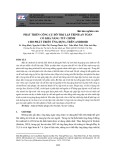
JOURNAL OF SCIENCE AND TECHNOLOGY DONG NAI TECHNOLOGY UNIVERSITY
160
Special Issue
EFFICIENT INTERACTION RECOGNITION IN VIDEO FOR EDGE
DEVICES: A LIGHTWEIGHT APPROACH
Quoc Bao Do*, Hoang Tan Huynh, Thi Lieu Nguyen, Ngoc Mai Nguyen
Dong Nai Technology University
*Corresponding author: Quoc Bao Do, doquocbao@dntu.edu.vn
GENERAL INFORMATION
ABSTRACT
Received date: 30/03/2024
Efficient and accurate recognition of human interactions is
crucial for numerous service applications, including security
surveillance and public safety. However, achieving real-time
interaction recognition on resource-constrained edge devices
poses significant computational challenges. In this paper, we
propose a lightweight methodology for detecting human
activity and interactions in video streams, specifically
tailored for edge computing environments. Our approach
utilizes distance estimation and interaction detection based
on pose estimation techniques, enabling rapid analysis of
video data while conserving computational resources. By
leveraging a distance grid for proximity analysis and
TensorFlow's MoveNet for pose estimation, our method
achieves promising results in interaction recognition. We
demonstrate the feasibility of our approach through empirical
evaluation and discuss its potential implications for real-
world deployment on edge devices.
Revised date: 07/05/2024
Accepted date: 11/07/2024
KEYWORD
Interaction recognition;
Edge devices;
Lightweight methodology;
Pose estimation;
Real-time analysis;
1. INTRODUCTION
The realm of computer vision has
witnessed remarkable advancements,
particularly in the domain of action
recognition within videos. This
technological niche holds immense potential
for diverse applications, ranging from
bolstering security measures to enhancing
public safety and refining sports analytics
(Y. Wang et al., 2023). The ability to discern
and interpret human actions depicted in
video streams not only facilitates
surveillance and monitoring but also opens
avenues for immersive gaming experiences
and interactive user interfaces (Kim et al.,
2021; Patrikar & Parate, 2022; F. Wang et
al., 2020).
The fruition of robust action recognition
systems is impeded by the substantial
computational resources they demand. The
intricacies of data collection, preprocessing,
feature extraction, predictive modeling, and
post-processing pose significant challenges,
particularly when attempting to integrate
such systems into resource-constrained edge
devices, such as smart Closed-Circuit
Television (CCTV) setups (Azimi et al.,
2023; Guo et al., 2019).
While action recognition systems have
made significant strides, the subset of

161
JOURNAL OF SCIENCE AND TECHNOLOGY DONG NAI TECHNOLOGY UNIVERSITY
Special Issue
interaction recognition presents an even
more formidable challenge. Interaction
recognition entails discerning and analyzing
the nuanced actions and gestures exchanged
among multiple individuals within a scene
(Deng et al., 2020). The ability to detect and
interpret interactions in real-time holds
immense promise, particularly in contexts
where swift responses are imperative, such
as crime prevention and emergency response
scenarios (Ezzat et al., 2021; Nikouei et al.,
2021).
This paper presents a novel approach
tailored for interaction recognition in video
streams, specifically optimized for edge
computing environments. By leveraging
lightweight algorithms and innovative
methodologies, we aim to enable real-time
interaction detection on edge devices,
thereby empowering these systems to
contribute meaningfully to societal welfare
and safety. Through a combination of
distance estimation, pose analysis, and
activity detection techniques, our proposed
method endeavors to overcome the
computational constraints inherent in edge
computing while delivering accurate and
timely interaction recognition capabilities.
We delve into the intricacies of our proposed
method, elucidating its underlying
mechanisms, implementation details, and
empirical results. By presenting a
comprehensive overview of our approach,
we aspire to contribute to the burgeoning
field of computer vision and edge
computing, fostering advancements that
resonate across various domains, from
security and surveillance to healthcare and
beyond (Huang et al., 2021; Q. Wang et al.,
2024).
2. RELATED WORKS
Numerous studies have explored the
realm of interaction recognition, leveraging
various methodologies and technologies to
achieve accurate and efficient analysis of
human activities in video data. One
prominent line of research focuses on the
utilization of deep learning techniques for
pose estimation and activity recognition.
Models such as OpenPose and PoseNet have
demonstrated remarkable capabilities in
detecting human poses and inferring actions
from video sequences, laying the foundation
for subsequent advancements in interaction
recognition.
Another area of interest lies in the
development of lightweight algorithms and
architectures tailored for edge computing
environments. Researchers have proposed
novel approaches for optimizing pose
estimation and activity analysis algorithms
to operate efficiently on resource-
constrained edge devices. By leveraging
techniques such as model quantization,
network pruning, and hardware acceleration,
these studies have enabled real-time
interaction recognition on edge devices with
limited computational capabilities.
The efforts have been made to explore
the fusion of multiple modalities, such as
audio and visual cues, for enhanced
interaction recognition. Studies have
demonstrated the synergistic benefits of
combining audio-based event detection with
visual analysis techniques, leading to
improved accuracy and robustness in
recognizing complex interactions.
Furthermore, the integration of context-
awareness and semantic understanding has
emerged as a promising direction for
enriching interaction recognition systems
with contextual information.

JOURNAL OF SCIENCE AND TECHNOLOGY DONG NAI TECHNOLOGY UNIVERSITY
162
Special Issue
The advancements in federated learning
and distributed computing have paved the
way for collaborative interaction recognition
across networked edge devices. Researchers
have proposed federated learning
frameworks that enable edge devices to
collectively train interaction recognition
models while preserving data privacy and
security. By harnessing the collective
intelligence of edge devices, these
approaches facilitate scalable and
decentralized interaction analysis in
dynamic and distributed environments.
3. METHODOLOGY
Data Collection and Preprocessing: The
methodology initiates with meticulous data
collection to curate a diverse and
representative dataset suitable for training
and testing the interaction recognition
model. This dataset encompasses a wide
array of human interactions, meticulously
selected to encapsulate various scenarios
encountered in real-world environments.
Subsequently, the collected data undergoes
rigorous preprocessing, wherein it is
standardized in terms of format, resolution,
and encoding. Noise reduction techniques
are applied to enhance the clarity of the
video content, ensuring optimal performance
during subsequent processing stages. The
basic process of the proposed method is
shown in Figure 1.
Figure 1. The basic process of the proposed
method
Feature extraction: Feature extraction
serves as a pivotal step in the interaction
recognition pipeline, wherein relevant
information is distilled from the raw video
frames to facilitate subsequent analysis. In
our methodology, feature extraction is
primarily achieved through the application
of advanced pose estimation algorithms.
These algorithms meticulously extract key
body landmarks and spatial configurations
from each frame, enabling the representation
of human poses in a compact and
informative manner. This foundational step
lays the groundwork for subsequent
interaction analysis.
Interaction detection: The core of our
methodology revolves around the detection
of interpersonal interactions within the video
stream. This process commences with the
estimation of distances between individuals
present in the scene. Leveraging the spatial
relationships encoded in the pose estimates,
the system determines the proximity of
individuals and triggers interaction analysis
when they come into close contact. To
achieve efficient interaction detection, a
distance grid approach is employed. A
meticulously calibrated distance grid is
generated based on known physical
dimensions and camera parameters,
facilitating the estimation of real-world
distances between individuals.
Activity analysis: Upon detecting
instances of close proximity between
individuals, the system proceeds to activity
analysis, wherein it discerns the nature of
the interaction. This stage involves the
application of a pre-trained custom pose
estimation model tailored specifically for
interaction recognition. The model is adept
at classifying various interaction types based
on the spatial configurations and temporal

163
JOURNAL OF SCIENCE AND TECHNOLOGY DONG NAI TECHNOLOGY UNIVERSITY
Special Issue
dynamics of the detected poses. Activities
such as conversations, handshakes, and
physical gestures are identified and
annotated in real-time, enabling
comprehensive interaction analysis.
Implementation details: The proposed
methodology is underpinned by state-of-the-
art deep learning frameworks and libraries,
including TensorFlow and OpenCV. Pose
estimation models, such as MoveNet, are
employed for extracting key body
landmarks, while custom neural network
architectures are trained for interaction
recognition. Model training is conducted on
high-performance computing infrastructure,
with graphics processing units (GPUs)
utilized to expedite the optimization process.
Evaluation metrics: The performance of
the interaction recognition system is
rigorously evaluated using standard metrics,
including precision, recall, and F1-score.
Additionally, qualitative assessments may be
conducted to gauge the system's robustness
to various environmental conditions and
interaction scenarios.
Deployment and optimization: Once
trained and validated, the interaction
recognition model is seamlessly deployed on
edge computing devices, such as smart
CCTV cameras or IoT devices. Model
optimization techniques, including
quantization and pruning, are employed to
minimize memory and computational
requirements, ensuring efficient operation on
resource-constrained hardware platforms.
The proposed methodology for
interaction recognition on edge devices
combines pose estimation using
TensorFlow's MoveNet with a distance-
based interaction detection approach. This
method is designed to be lightweight and
efficient, making it suitable for deployment
on resource-constrained edge devices. The
core components include pose estimation,
distance grid calibration, and interaction
detection.
Pose estimation with MoveNet: Pose
estimation is the first step in the interaction
recognition pipeline. MoveNet, a highly
efficient deep learning model, is used for
this purpose. Video frames are captured
from the camera and fed into the MoveNet
model. MoveNet detects 17 keypoints on the
human body, including key positions such as
the head, shoulders, elbows, wrists, hips,
knees, and ankles. The coordinates of the
keypoints are extracted for each person in
the frame. This information is used to create
bounding boxes around each detected
person, isolating individual figures for
further analysis.
Distance grid calibration: To accurately
estimate the distance between individuals, a
distance grid is generated through a
calibration process. A reference object of
known dimensions (e.g., a meter stick) is
placed within the camera's view to establish
a correlation between image pixels and real-
world distances. Using the reference object,
a grid is overlaid on the video frame. Each
cell in the grid represents a fixed real-world
distance (e.g., 50 cm). This grid is used to
rapidly estimate distances by counting the
number of cells between detected keypoints.
Distance calculation and proximity
detection: Distance calculation between
individuals is performed using the calibrated
grid. For each frame, the detected keypoints
(particularly those on the feet) are mapped
onto the distance grid. The number of grid
cells between the keypoints of different
individuals is counted. For example, if there
are 7 cells between two keypoints and each

JOURNAL OF SCIENCE AND TECHNOLOGY DONG NAI TECHNOLOGY UNIVERSITY
164
Special Issue
cell represents 50 cm, the estimated distance
is 3.5 meters. A predefined threshold (e.g.,
1.5 meters) is used to determine if
individuals are close enough to interact. If
the distance between two individuals is less
than this threshold, interaction detection is
triggered.
Interaction detection: Interaction
detection is performed when individuals are
within the defined proximity threshold.
Once proximity is established, the "Activity
Analysis" block uses a custom-trained pose
estimation model to classify specific
interactions. This model is trained to
recognize predefined interactions such as
handshakes, high-fives, conversations,
kicking, and hitting. The custom model is
trained using a dataset of 800 videos and
images collected via web crawling. This
dataset includes various interaction types to
ensure robust training. The current model
accuracy is approximately 65%, with plans
for further improvement through increased
training data and model optimization.
Integration and deployment: The trained
pose estimation and interaction detection
models are converted to TensorFlow Lite
format for deployment on Android devices.
TensorFlow Lite is optimized for mobile and
edge deployment, ensuring efficient
inference on resource-constrained devices.
The system processes live video streams
from the device's camera, applying pose
estimation, distance calculation, and
interaction detection in real-time. The
effectiveness of the proposed method is
demonstrated through examples of
interaction recognition, showing the
system's capability to accurately detect and
classify interactions in real-time video
streams.
Illustration and validation: Figure 2
illustrates the process of distance estimation
using the distance grid. Keypoints on the
feet of detected individuals are compared
against the grid to estimate their locations
and the distance between them. Figure 3
provides examples of interaction recognition
results, showcasing the system's ability to
identify various interactions such as
handshakes and high-fives. By providing a
detailed breakdown of each component and
the overall process, this methodology
section aims to enhance reader
understanding and facilitate replicability of
the proposed interaction recognition
approach on edge devices.
4. IMPLEMENTATION AND RESULTS
To estimate the location and distance
between subjects, a distance grid is
generated through a calibration process.
Keypoints detected from pose estimation are
utilized to create a bounding box for each
individual. The calibrator incorporates
height information and computed bounding
box height to establish the correspondence
between image pixels and actual distance
metrics. Utilizing this correspondence, a
distance grid specific to the current scene is
generated. When individuals appear within
the scene, their foot keypoints are compared
with the grid to estimate their respective
locations. Simple grid counting techniques
are then employed to estimate the distance
between individuals, as depicted in Figure
2. For instance, if there are 7 grids between
two people, and each grid represents 50 cm,
then the estimated distance is approximately
3.5 meters.

![Tài liệu giảng dạy Hệ điều hành [mới nhất]](https://cdn.tailieu.vn/images/document/thumbnail/2025/20250516/phongtrongkim0906/135x160/866_tai-lieu-giang-day-he-dieu-hanh.jpg)










![Đề thi Excel: Tổng hợp [Năm] mới nhất, có đáp án, chuẩn nhất](https://cdn.tailieu.vn/images/document/thumbnail/2025/20251103/21139086@st.hcmuaf.edu.vn/135x160/61461762222060.jpg)


![Bài tập Tin học đại cương [kèm lời giải/ đáp án/ mới nhất]](https://cdn.tailieu.vn/images/document/thumbnail/2025/20251018/pobbniichan@gmail.com/135x160/16651760753844.jpg)
![Bài giảng Nhập môn Tin học và kỹ năng số [Mới nhất]](https://cdn.tailieu.vn/images/document/thumbnail/2025/20251003/thuhangvictory/135x160/33061759734261.jpg)
![Tài liệu ôn tập Lý thuyết và Thực hành môn Tin học [mới nhất/chuẩn nhất]](https://cdn.tailieu.vn/images/document/thumbnail/2025/20251001/kimphuong1001/135x160/49521759302088.jpg)


![Trắc nghiệm Tin học cơ sở: Tổng hợp bài tập và đáp án [mới nhất]](https://cdn.tailieu.vn/images/document/thumbnail/2025/20250919/kimphuong1001/135x160/59911758271235.jpg)


![Giáo trình Lý thuyết PowerPoint: Trung tâm Tin học MS [Chuẩn Nhất]](https://cdn.tailieu.vn/images/document/thumbnail/2025/20250911/hohoainhan_85/135x160/42601757648546.jpg)


